Deep Learning and Embedding Based Latent Factor Model for Collaborative Recommender Systems
Abstract
1. Introduction
- We develop a dual DNN structure to extract the non-linear representation of users’ and items’ latent factors in their respective spaces separately.
- We construct a robust DL and embedding-based latent factor model. The method effectively alleviates sparsity problems by combining deep learning and embedding techniques.
- We conduct an extensive experiment on two real-world datasets to predict the rating score. The result demonstrates that DELCR improves the performance of the recommendation to the state-of-the-art level.
2. Preliminaries
2.1. Problem Statement
2.2. Learning the Model
3. Related Work
3.1. Latent Factor Model for Recommender Systems
3.2. Deep Learning-Based Recommender Systems
4. The Proposed Model
4.1. DMF Method
4.2. Overview of the Architecture
- To handle sparsity problems, the method first learns the unknown rating values from the user–item interaction matrix R.
- We use embedding techniques to learn those missed values from existing ratings.
- The ultimate goal of the model is to predict the ratings using two fully connected deep neural networks.
4.3. Latent Factor Model
5. Experiments
- RQ1 Does our method outperform the baseline models?
- RQ2 How does the use of the embedding techniques improve the recommendation performance?
- RQ3 How does the performance of DELCR vary with different hyper-parameter values?
5.1. Experimental Datasets
5.2. Evaluation Protocol
5.3. Baseline Methods
- For collaborative filtering, MDA employs an autoencoder architecture with MF for model prediction [35].
- CDL provides a hierarchical Bayesian model by combining two methods. It enables the acquisition of an appropriate latent feature to address the sparsity problem [12].
- RMF model uses Manhattan distance to minimize the distances within matrices. It successfully solves the problem of data sparsity [36].
- DMF is a Deep MF model that uses MLP to transform the representation of the user and item [8].
- HLFM is one of the MF-based algorithms that investigates the underlying hierarchical characteristics of users and items. To increase the effectiveness of RSs, the approach integrates the hierarchy of items as well as user preferences [37].
- DLFCF is a CF model based on latent factors. The model uses deep factorization on users and items to determine their latent representation vectors [29].
- DELCR is the model presented in this paper.
5.4. Parameter Settings
5.5. Experimental Results
6. Discussion
6.1. Performance Comparison (RQ1)
- According to Table 4, the proposed method, DELCR, outperforms all other methods for both datasets. Particularly when contrasted to our highly motivated DMF model, our DELCR approach with ML-100K results in a relative improvement of 8.30% of MAE and 8.94% of RMSE. In addition, the method delivers a relative improvement with MAE of 6.95% and RMSE of 6.83% for the ML-1M dataset. Furthermore, when contrasted to the DL-based models, CDL and MDA, the advances made by our model are significant. For these two particular models, there is an average relative improvement of 10.12% of MAE and 11.46% of RMSE for the ML-100K dataset whereas, for ML-1M dataset, there is an average relative improvement of 6.48% of MAE and 6.51% of RMSE. The reasons for this best performance achievement are: (i) the use of embedded ratings will effectively alleviate the problem of the sparse dataset and (ii) the separate mapping of these dense embedded vectors to our proposed architecture helps to discover the complex and abstract latent features of these two different entities called users and items effectively.
- Once more, the discrepancy between the DELCR and RMF methods is significant. When we see the comparison with the ML-100K dataset, we got a 7.92% and 8.74% MAE and RMSE relative improvement, respectively. For the ML-1M dataset, the method gives a relative improvement with 6.68% of MAE and 6.62% of RMSE. This means that using a deep learning architecture allows us to successfully extract the latent variables in our data, which was previously the fundamental constraint of most classic matrix factorization-based models.
- When we evaluate DELCR, with the state-of-the-art latent factor models HLFM and DLFCF, DELCR produces relatively minimal improvement results for MAE and RMSE as compared to the other methods. This is expected as the model follows the latent factor approach. In spite of this, the proposed model improvement result is due to the effectiveness of the architecture in mining the latent features in a robust way. In addition, when we see improvements made by the proposed method among the two used datasets, our method yields a better result for the ML-100K dataset than ML-1M. This achievement demonstrates that DELCR effectively alleviates the problem of data sparsity since ML-100K is relatively sparser than ML-1M. In general, our method outperforms all other methods in terms of improving the quality of recommendations. This performance improvement shows the effectiveness of an embedding technique and the use of a dual deep-learning architecture in the proposed method.
6.2. Effect of Embedding (RQ2)
6.3. Sensitivity to Hyper-Parameters (RQ3)
6.3.1. Depth of Layers in the Network
6.3.2. Number of Nodes in Each Layer
6.3.3. Number of Nodes in the Final Hidden Layers
7. Conclusions
Author Contributions
Funding
Institutional Review Board Statement
Informed Consent Statement
Data Availability Statement
Conflicts of Interest
References
- Pawlicka, A.; Pawlicki, M.; Kozik, R.; Choraś, R.S. A systematic review of recommender systems and their applications in cybersecurity. Sensors 2021, 21, 5248. [Google Scholar] [CrossRef] [PubMed]
- Ricci, F.; Rokach, L.; Shapira, B. Recommender systems: Introduction and challenges. In Recommender Systems Handbook; Springer: Boston, MA, USA, 2015; pp. 1–34. [Google Scholar]
- Sun, Z.; Guo, Q.; Yang, J.; Fang, H.; Guo, G.; Zhang, J.; Burke, R. Research commentary on recommendations with side information: A survey and research directions. Electron. Commer. Res. Appl. 2019, 37, 100879. [Google Scholar] [CrossRef]
- Catherine, R.; Mazaitis, K.; Eskenazi, M.; Cohen, W. Explainable entity-based recommendations with knowledge graphs. arXiv 2017, arXiv:1707.05254. [Google Scholar]
- Wang, H.; Zhang, F.; Hou, M.; Xie, X.; Guo, M.; Liu, Q. Shine: Signed heterogeneous information network embedding for sentiment link prediction. In Proceedings of the Eleventh ACM International Conference on Web Search and Data Mining, Marina Del Rey, CA, USA, 5–9 February 2018; pp. 592–600. [Google Scholar]
- Sun, Y.; Yuan, N.J.; Xie, X.; McDonald, K.; Zhang, R. Collaborative intent prediction with real-time contextual data. ACM Trans. Inf. Syst. (TOIS) 2017, 35, 1–33. [Google Scholar] [CrossRef]
- Wang, Y.; Deng, J.; Gao, J.; Zhang, P. A hybrid user similarity model for collaborative filtering. Inf. Sci. 2017, 418, 102–118. [Google Scholar] [CrossRef]
- Xue, H.J.; Dai, X.; Zhang, J.; Huang, S.; Chen, J. Deep matrix factorization models for recommender systems. In Proceedings of the 26th International Joint Conference on Artificial Intelligence, Melbourne, Australia, 19–25 August 2017; Volume 17, pp. 3203–3209. [Google Scholar]
- Yagci, A.M.; Aytekin, T.; Gurgen, F.S. A Meta-Algorithm for Improving Top-N Prediction Efficiency of Matrix Factorization Models in Collaborative Filtering. Int. J. Pattern Recognit. Artif. Intell. 2020, 34, 2059007. [Google Scholar] [CrossRef]
- He, X.; Zhang, H.; Kan, M.Y.; Chua, T.S. Fast matrix factorization for online recommendation with implicit feedback. In Proceedings of the 39th International ACM SIGIR Conference on Research and Development in Information Retrieval, Pisa, Italy, 17–21 July 2016; pp. 549–558. [Google Scholar]
- Koren, Y.; Bell, R.; Volinsky, C. Matrix factorization techniques for recommender systems. Computer 2009, 42, 30–37. [Google Scholar] [CrossRef]
- Wang, H.; Wang, N.; Yeung, D.Y. Collaborative deep learning for recommender systems. In Proceedings of the 21th ACM SIGKDD International Conference on Knowledge Discovery and Data Mining, Sydney, Australia, 10–13 August 2015; pp. 1235–1244. [Google Scholar]
- Guo, L.; Ma, J.; Chen, Z.; Zhong, H. Learning to recommend with social contextual information from implicit feedback. Soft Comput. 2015, 19, 1351–1362. [Google Scholar] [CrossRef]
- Gu, Y.; Yang, X.; Peng, M.; Lin, G. Robust weighted SVD-type latent factor models for rating prediction. Expert Syst. Appl. 2020, 141, 112885. [Google Scholar] [CrossRef]
- Bengio, Y. Learning deep architectures for AI. Found. Trends® Mach. Learn. 2009, 2, 1–127. [Google Scholar] [CrossRef]
- Hinton, G.E. Deep belief networks. Scholarpedia 2009, 4, 5947. [Google Scholar] [CrossRef]
- Adnan, M.; Habib, A.; Ashraf, J.; Mussadiq, S.; ALI, A. Deep neural network based m-learning model for predicting mobile learners’ performance. Turk. J. Electr. Eng. Comput. Sci. 2020, 28, 1422–1441. [Google Scholar] [CrossRef]
- Dang, D.; Chen, C.; Li, H.; Yan, R.; Guo, Z.; Wang, X. Deep knowledge-aware framework for web service recommendation. J. Supercomput. 2021, 77, 14280–14304. [Google Scholar] [CrossRef]
- Tegene, A.T.; Liu, Q.; Muhammed, S.B.; Leka, H.L. Deep Learning Based Matrix Factorization For Collaborative Filtering. In Proceedings of the 2021 18th International Computer Conference on Wavelet Active Media Technology and Information Processing (ICCWAMTIP), Chengdu, China, 17–19 December 2021; pp. 165–170. [Google Scholar]
- Zhang, S.; Yao, L.; Sun, A.; Tay, Y. Deep learning based recommender system: A survey and new perspectives. ACM Comput. Surv. (CSUR) 2019, 52, 1–38. [Google Scholar] [CrossRef]
- He, X.; Liao, L.; Zhang, H.; Nie, L.; Hu, X.; Chua, T.S. Neural collaborative filtering. In Proceedings of the 26th International Conference on World Wide Web, Perth, Australia, 3–7 April 2017; pp. 173–182. [Google Scholar]
- Salakhutdinov, R.; Mnih, A.; Hinton, G. Restricted Boltzmann machines for collaborative filtering. In Proceedings of the 24th International Conference on Machine Learning, Corvalis, OR, USA, 20–24 June 2007; pp. 791–798. [Google Scholar]
- Wang, S.; Sun, G.; Li, Y. SVD++ recommendation algorithm based on backtracking. Information 2020, 11, 369. [Google Scholar] [CrossRef]
- Rendle, S. Factorization machines with libfm. ACM Trans. Intell. Syst. Technol. (TIST) 2012, 3, 1–22. [Google Scholar] [CrossRef]
- Guo, H.; Tang, R.; Ye, Y.; Li, Z.; He, X. DeepFM: A factorization-machine based neural network for CTR prediction. arXiv 2017, arXiv:1703.04247. [Google Scholar]
- Covington, P.; Adams, J.; Sargin, E. Deep neural networks for youtube recommendations. In Proceedings of the 10th ACM Conference on Recommender Systems, Boston, MA, USA, 15–19 September 2016; pp. 191–198. [Google Scholar]
- Gomez-Uribe, C.A.; Hunt, N. The netflix recommender system: Algorithms, business value, and innovation. ACM Trans. Manag. Inf. Syst. (TMIS) 2015, 6, 1–19. [Google Scholar] [CrossRef]
- Wu, D.; Luo, X.; Shang, M.; He, Y.; Wang, G.; Zhou, M. A deep latent factor model for high-dimensional and sparse matrices in recommender systems. IEEE Trans. Syst. Man Cybern. Syst. 2019, 51, 4285–4296. [Google Scholar] [CrossRef]
- Mongia, A.; Jhamb, N.; Chouzenoux, E.; Majumdar, A. Deep latent factor model for collaborative filtering. Signal Process. 2020, 169, 107366. [Google Scholar] [CrossRef]
- Nassar, N.; Jafar, A.; Rahhal, Y. A novel deep multi-criteria collaborative filtering model for recommendation system. Knowl.-Based Syst. 2020, 187, 104811. [Google Scholar] [CrossRef]
- Cheng, W.; Shen, Y.; Zhu, Y.; Huang, L. DELF: A Dual-Embedding based Deep Latent Factor Model for Recommendation. In Proceedings of the IJCAI, Stockholm, Sweden, 13–19 July 2018; Volume 18, pp. 3329–3335. [Google Scholar]
- He, G.; Zhao, D.; Ding, L. Dual-embedding based Neural Collaborative Filtering for Recommender Systems. arXiv 2021, arXiv:2102.02549. [Google Scholar]
- Kingma, D.P.; Ba, J. Adam: A method for stochastic optimization. arXiv 2014, arXiv:1412.6980. [Google Scholar]
- Shi, C.; Hu, B.; Zhao, W.X.; Philip, S.Y. Heterogeneous information network embedding for recommendation. IEEE Trans. Knowl. Data Eng. 2018, 31, 357–370. [Google Scholar] [CrossRef]
- Li, S.; Kawale, J.; Fu, Y. Deep collaborative filtering via marginalized denoising auto-encoder. In Proceedings of the 24th ACM International on Conference on Information and Knowledge Management, Melbourne, Australia, 18–23 October 2015; pp. 811–820. [Google Scholar]
- Liu, T.; Tao, D. On the performance of manhattan nonnegative matrix factorization. IEEE Trans. Neural Netw. Learn. Syst. 2015, 27, 1851–1863. [Google Scholar] [CrossRef] [PubMed]
- Wang, S.; Tang, J.; Wang, Y.; Liu, H. Exploring hierarchical structures for recommender systems. IEEE Trans. Knowl. Data Eng. 2018, 30, 1022–1035. [Google Scholar] [CrossRef]
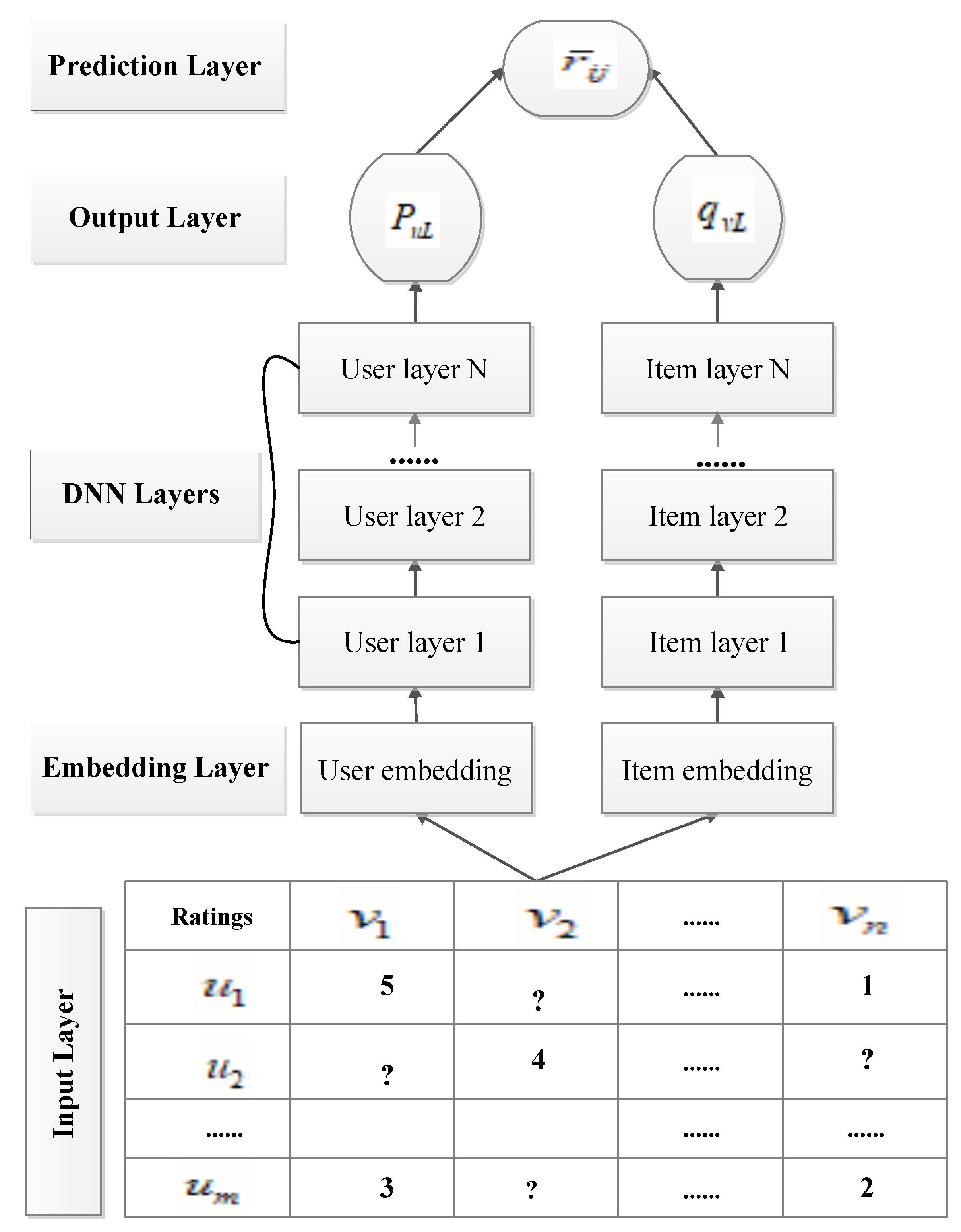
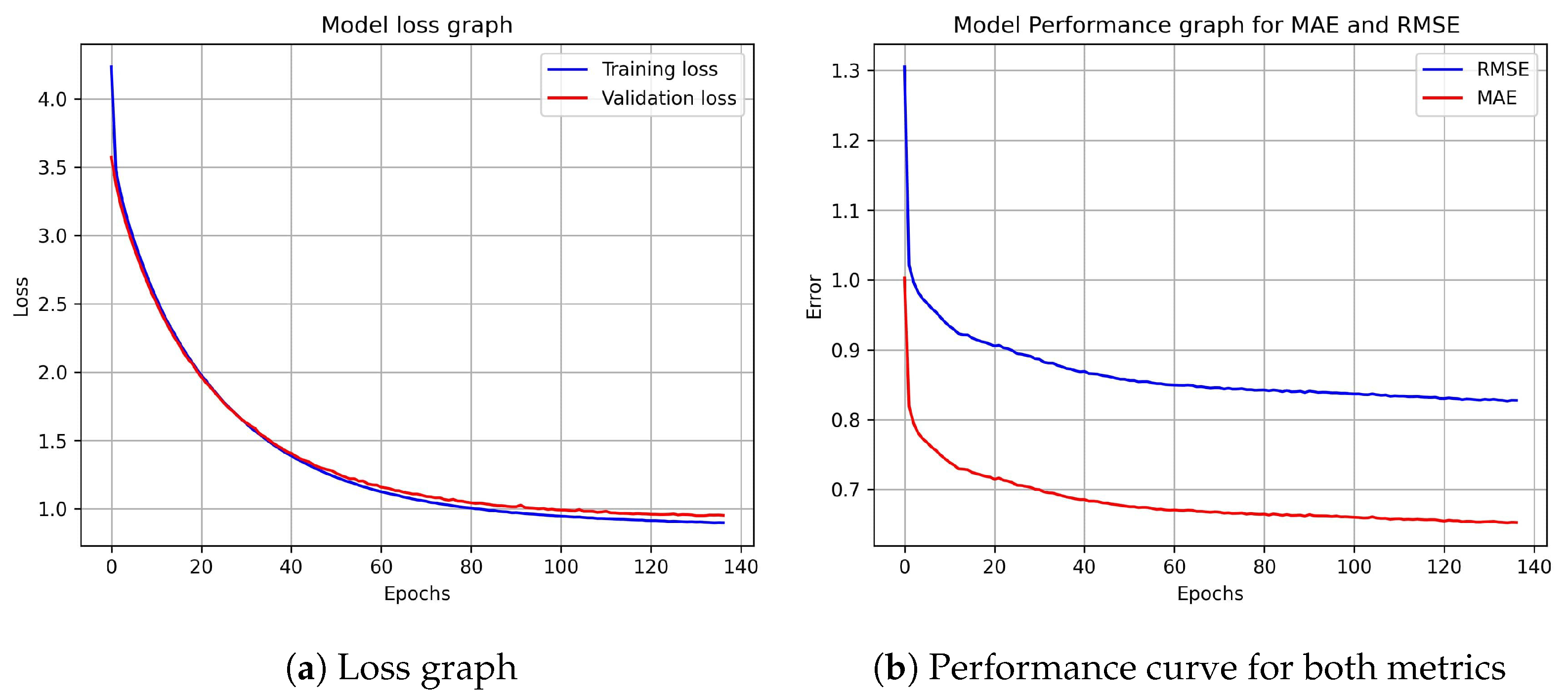
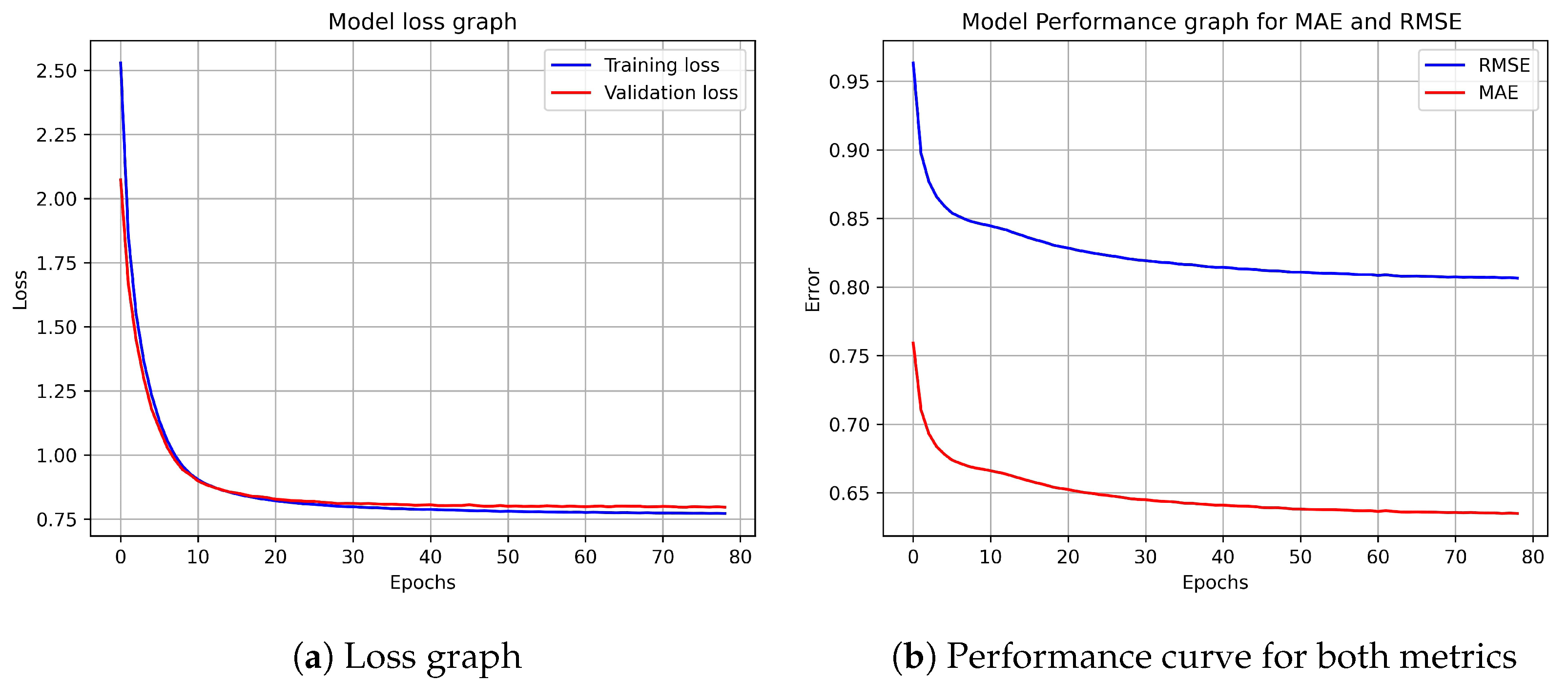
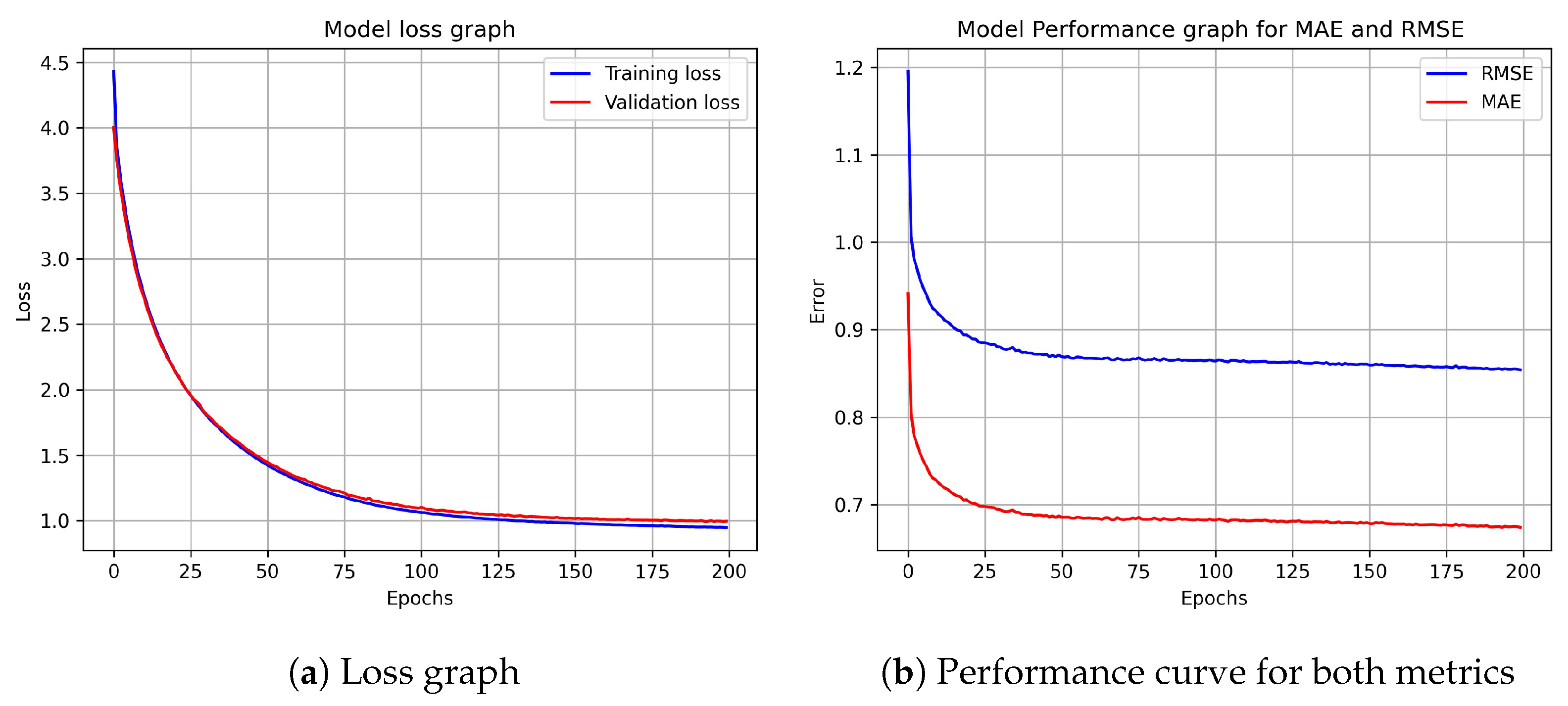
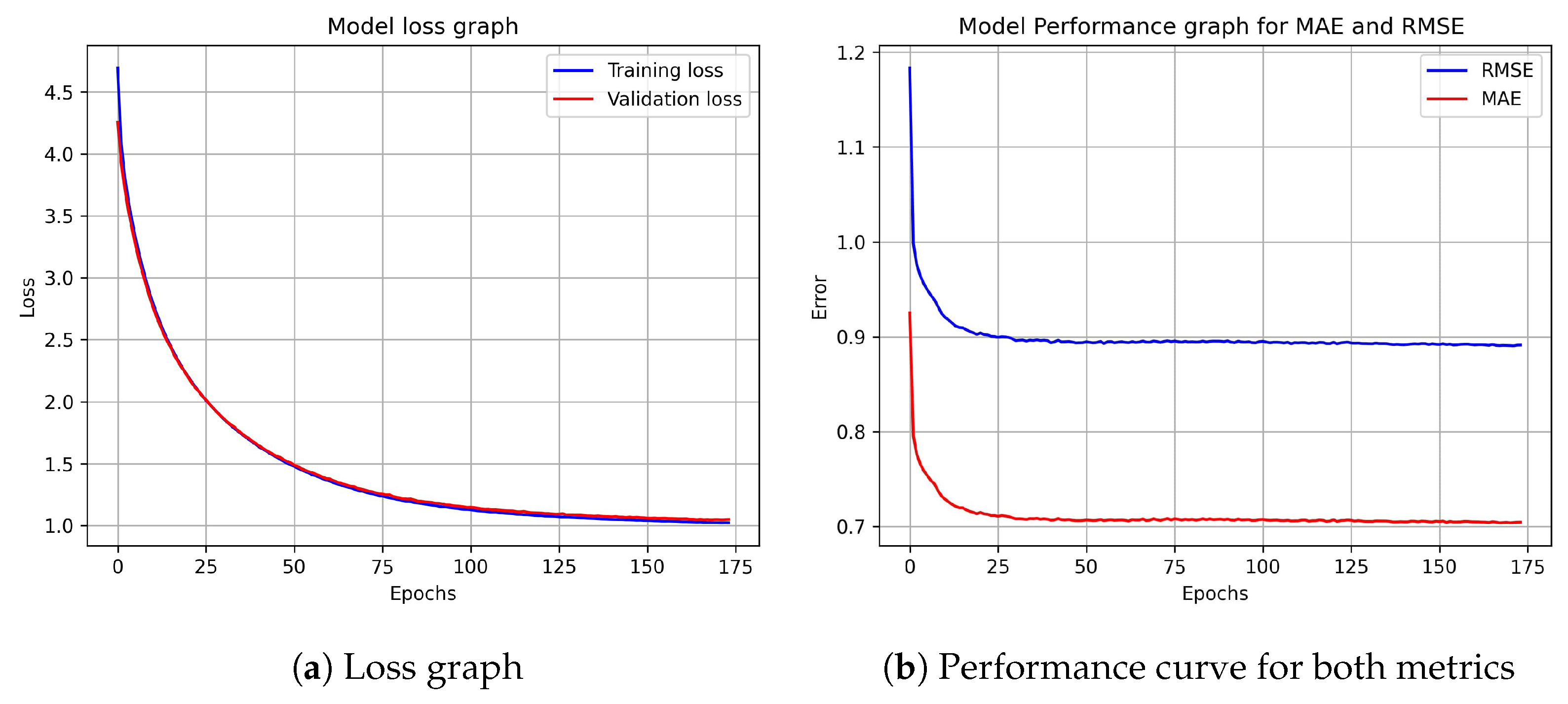
| Datasets | Users | Items | Ratings | Rating Density |
|---|---|---|---|---|
| ML-100K | 944 | 1683 | 100,000 | 6.3% |
| ML-1M | 6040 | 3706 | 1,000,208 | 4.5% |
| Folds | For ML-100K | For ML-1M | ||
|---|---|---|---|---|
| MAE | RMSE | MAE | RMSE | |
| Fold 1 | 0.672 ± 0.005 | 0.855 ± 0.005 | 0.643 ± 0.007 | 0.818 ± 0.004 |
| Fold 2 | 0.674 ± 0.003 | 0.857 ± 0.007 | 0.642 ± 0.005 | 0.817 ± 0.006 |
| Fold 3 | 0.671 ± 0.004 | 0.853 ± 0.002 | 0.644 ± 0.003 | 0.817 ± 0.001 |
| Fold 4 | 0.673 ± 0.007 | 0.855 ± 0.007 | 0.642 ± 0.001 | 0.818 ± 0.004 |
| Fold 5 | 0.675 ± 0.007 | 0.858 ± 0.003 | 0.641 ± 0.003 | 0.818 ± 0.003 |
| Methods | For ML-100K | For ML-1M | ||
|---|---|---|---|---|
| MAE | RMSE | MAE | RMSE | |
| MDA | 0.758 | 0.981 | 0.686 | 0.879 |
| CDL | 0.742 | 0.953 | 0.689 | 0.871 |
| RMF | 0.732 | 0.938 | 0.689 | 0.876 |
| DMF | 0.735 | 0.940 | 0.691 | 0.878 |
| HLFM | 0.750 | 0.962 | 0.698 | 0.880 |
| DLFCF | 0.717 | 0.901 | 0.678 | 0.854 |
| DELCR | 0.674 | 0.856 | 0.643 | 0.818 |
| Methods | For ML-100k | For ML-1M | ||
|---|---|---|---|---|
| MAE | RMSE | MAE | RMSE | |
| MDA | 11.08% | 12.74% | 6.27% | 6.94% |
| CDL | 9.16% | 10.18% | 6.68% | 6.08% |
| RMF | 7.92% | 8.74% | 6.68% | 6.62% |
| DMF | 8.30% | 8.94% | 6.95% | 6.83% |
| HLFM | 10.13% | 11.02% | 7.88% | 7.05% |
| DLFCF | 6.00% | 5.00% | 5.16% | 4.22% |
| Models | ML-100K | ML-1M | ||
|---|---|---|---|---|
| MAE | RMSE | MAE | RMSE | |
| DCF | 0.698 | 0.887 | 0.662 | 0.842 |
| DELCR | 0.674 | 0.856 | 0.643 | 0.818 |
| Models | For ML-100k | For ML-1M | ||
|---|---|---|---|---|
| MAE | RMSE | MAE | RMSE | |
| Two layer | 0.674 | 0.856 | 0.643 | 0.818 |
| Three layer | 0.685 | 0.874 | 0.659 | 0.835 |
| Four layer | 0.707 | 0.896 | 0.677 | 0.860 |
| Metrics | Number of Neurons | |||||
|---|---|---|---|---|---|---|
| 20 | 30 | 40 | 50 | 60 | 70 | |
| MAE | 0.650 | 0.647 | 0.643 | 0.645 | 0.644 | 0.643 |
| RMSE | 0.825 | 0.823 | 0.818 | 0.819 | 0.820 | 0.818 |
Disclaimer/Publisher’s Note: The statements, opinions and data contained in all publications are solely those of the individual author(s) and contributor(s) and not of MDPI and/or the editor(s). MDPI and/or the editor(s) disclaim responsibility for any injury to people or property resulting from any ideas, methods, instructions or products referred to in the content. |
© 2023 by the authors. Licensee MDPI, Basel, Switzerland. This article is an open access article distributed under the terms and conditions of the Creative Commons Attribution (CC BY) license (https://creativecommons.org/licenses/by/4.0/).
Share and Cite
Tegene, A.; Liu, Q.; Gan, Y.; Dai, T.; Leka, H.; Ayenew, M. Deep Learning and Embedding Based Latent Factor Model for Collaborative Recommender Systems. Appl. Sci. 2023, 13, 726. https://doi.org/10.3390/app13020726
Tegene A, Liu Q, Gan Y, Dai T, Leka H, Ayenew M. Deep Learning and Embedding Based Latent Factor Model for Collaborative Recommender Systems. Applied Sciences. 2023; 13(2):726. https://doi.org/10.3390/app13020726
Chicago/Turabian StyleTegene, Abebe, Qiao Liu, Yanglei Gan, Tingting Dai, Habte Leka, and Melak Ayenew. 2023. "Deep Learning and Embedding Based Latent Factor Model for Collaborative Recommender Systems" Applied Sciences 13, no. 2: 726. https://doi.org/10.3390/app13020726
APA StyleTegene, A., Liu, Q., Gan, Y., Dai, T., Leka, H., & Ayenew, M. (2023). Deep Learning and Embedding Based Latent Factor Model for Collaborative Recommender Systems. Applied Sciences, 13(2), 726. https://doi.org/10.3390/app13020726






